Director Message

Welcome to the latest edition of Mitrais’ quarterly newsletter.
While the global environment remains challenging, it is refreshing to see that Mitrais and many of our valued clients are not only surviving the conditions, but are indeed forging ahead.
A perfect example is GroupMap, our featured client in this issue. The article details how GroupMap identified opportunities born out of global economic stress, and turned them into a suite of innovative products helping industry maintain “continuous improvement” on a global basis. And, not satisfied with their award-winning products, how they are now reimagining those tools by further enhancing their features and embracing their global customers’ needs. All with the help of their Mitrais team members!
For those with an interest in the technicalities of software development, our Senior Developers have put together a fascinating article on the right ways to implement Microservices Architecture. Boasting the ability to produce applications that feature scalability through smaller code-bases and greatly simplified development and maintenance of full-featured apps, Microservices Architecture is now a hot topic expected to become a multi-billion market over the next few years. Like all revolutionary ideas, though, it’s adoption requires some careful thought and planning to yield optimal results. In this piece, read some of the tips and tricks that Mitrais’ best operators have for successfully implementing Microservices Architecture in your applications to achieve the greatest benefits.
Finally, we dig down on the life experience of Arif Nazar Purwandaru, one of Mitrais elite Technical Evangelists. We learn how his parents once thought that introducing Arif to computers was a big mistake that had ruined his school performance, and how they actually banned him from anything to do with computers. Happily for everyone, though, Arif’s passion and curiosity helped him overcome his parents’ doubts, resulting in his exceptional career in Mitrais.
I hope that you enjoy these articles that all share in a positive and optimistic feel. Until the next newsletter, we wish you and your families continued good health and success.
Developing Invaluable Products for Forward-Thinking Customers - GroupMap

In the last few years, business has become an even more dynamic environment than in earlier times. This is particularly true in highly technical pursuits like software engineering, where the widespread adoption of Agile methodologies means that a team’s ability to make swift, educated decisions on project execution is a must.
But the old paradigms of whiteboards and sticky notes to support and manage key strategic decisions have not kept up. This was obvious in 2012 to Jeremy Lu and Brad Ward, (Co-founders).
Their response was to form the company and launch a suite of products aimed squarely at providing tools for high performance teams to manage group decision making, organise thoughts and drive group consensus. And it seems their vision was a shared one. The initial GroupMap application was immediately seen as an invaluable tool by forward-thinking customers, and was voted as finalists in the OzApps, iAwards and the Western Australian Information Technology and Telecommunications Alliance awards.
GroupMap helps facilitate team decision making and improved meetings with organisations around the world (including Mitrais). Jeremy explained “GroupMap creates tools for Facilitators, Scrum Masters, Team Leaders and consultants to improve the effectiveness and engagement in meetings with a guided facilitation tool and customisable templates where ideas can be shared, prioritised and actions created”.
But it didn’t stop there. Based on usage data, there was a growing trend of Agile development projects and Scrum Masters who wanted to run retrospectives. From this further innovation was undertaken to create another product.
TeamRetro is designed specifically for teams who want to run fun, effective, engaging and worthwhile agile retrospectives. It also lets you run health checks with the team and provides real time dashboards that allows you to track meeting cadence, team health and action status across all teams over a period of time. It’s been used by organisations globally across all verticals to support their own software product goals, human resource development and even marketing efforts.
It was vital to Jeremy and Brad that momentum be maintained – there is a pipeline of enhancements still coming. As Jeremy explained “Our customers are the key drivers of our product direction and it’s because of them, we have clarity over what we are doing in order to help them be more effective in the work that they do.” They reached out to Mitrais to augment their development team to deepen integrations, improve system capability and provide additional capacity to allow GroupMap to meet their goals.
Like Mitrais, GroupMap are interested in more than just a transactional relationship. As Jeremy says, “We chose to work with Mitrais because of their value for money and service capability as well as being able to create strong partnerships. We look forward to seeing how Mitrais can benefit from the use of TeamRetro and it’s been great to see the commitment, passion and interest from the Mitrais team-members, who feel like they are part of the fabric of the team”.
That passion is evident, as the Mitrais team members quickly recognised the benefits that GroupMap’s suite could yield for Mitrais’ 500+ developers. So positive was their response, that Mitrais is right now trialling GroupMap’s application suite internally with a view to potentially offering it to other clients for use in their projects.
It is a pleasure for Mitrais to be involved with GroupMap in the development of such innovative tools, and we hope to establish a long-term, high-trust relationship that helps Jeremy, Brad and the GroupMap team to achieve their goals.
Adopting Microservices Architecture by Implementing Microservices Patterns

Microservices architecture has become a popular application architecture to build new or modernize existing legacy applications. Microservices architecture offers independent deployment and scalability of application modules, which can reduce downtime and allow teams to maintain a smaller code base. However, not all companies that adopt microservices architecture achieve outcome they want. This paper will outline the definition and benefits of a microservices architecture,and expand on the microservices patterns which will reduce the risk of failure when implementing a microservices architecture.
I. Introduction
There is no clear and consistent definition of microservices architecture. Some have tried to define microservices architecture; for example, Chris Richardson stated, “Microservices – also known as the microservice architecture – is an architectural style that structures an application as a collection of services that are highly maintainable and testable; loosely coupled; independently deployable; organized around business capabilities; owned by a small team”.
Martin Fowler wrote, “Microservice architectural style is an approach to developing a single application as a suite of small services, each running in its own process and communicating with lightweight mechanisms, often an HTTP resource API. These services are built around business capabilities and independently deployable by fully automated deployment machinery”.
From these two definitions, we can see that there is no general consensus as to what microservices architecture encompasses.
What we can observe from industry definitions is that microservices have certain consistent characteristics:
- Small in size (more on this later)
- Focussed on one task
- Aligned with a bounded context; and
- Autonomous
I.1 Microservices Characteristics
I.1.1 Small
The definition of small is relative. This could be the number of lines of code in the application, the number of team members working on the application, size and weight of the application or a range of other measures. James Lewis, Technical Director at Thoughtworks, stated that “a microservice should be as big as my head.” This definition is ambiguous at first, however, the idea is that a microservice should be small enough to be understandable by the team assigned to it.
Dave Farley, the author of “Continuous Delivery” stated that “If you could rewrite it in a week or two, then that is how should small a microservice is”.
I.1.2 Focus on One Task
This is related to the ‘Separation of Concern’ principle to organize applications into defined sections, so that each section addresses a specific concern. In microservices, the sections are directly related to problem domains. Therefore, each microservice should focus only on tasks in one single problem domain.
I.1.3 Aligned with a bounded context
‘Bounded Context’ is an idea that comes from “Domain Driven Design” as presented by Eric Evan in his 2003 book. He explained that a ‘Bounded Context’ is a defined part of the software where particular terms, definitions, and rules apply in a consistent way so that it makes a cohesive unit. Although this concept can be applied to any context, in microservices this is key because it provides a clear boundary with which to align the elements that make up the microservices.
In traditional development, applications are broken down into smaller technical services – however, this does not qualify as microservices because it is not aligned with the ‘Bounded Context’ principle, and creates coupling between the services themselves.
I.1.4 Autonomous
What makes microservices autonomous is that any implementation changes can be applied without coordinating with other microservices across the application. This allows microservices to scale enormously in an organization and this provides the greatest opportunity for delivering value in implementing microservices. However, this is also the part that is often misunderstood when implementing microservices. Developers frequently claim that they are implementing this architecture, but they must also build, test, and deploy the microservices together, which runs against the foundational principle of the architecture.
I.2 Microservices Adoption
More and more companies are adopting microservices. Based on the “Cloud Microservices – Global Market Trajectory & Analytics” report from Research and Market, the microservices market will grow 19.2 percent over the period 2020-2027 which is equates to about US$2.8 Billion. This is because companies want to take advantage of the benefits of microservices, such as allowing teams to implement or change features without impacting other services and getting to market faster because teams only need to change a small portion of the applications. However, adopting microservices is quite challenging. O’Reilly in their “Microservices Adoption in 2020” survey found that 10% of the respondents reported “complete success”, 54% reported being “mostly successful”, and 92% reported “at least some success”. While adoption is growing, it would appear that not all companies have achieved a successful microservices implementation.
The biggest challenges that the respondents to the “Microservices Adoption in 2020” survey mentioned are decomposition and complexity. At first, decomposing a large application sounds easy – however doing it the wrong way will only create other problems, like creating a coupled distributed application, creating increased complexity. As a result, rather than utilising microservices, the app ends up as a distributed monolith, which does not offer the benefits of the microservices architecture.
To minimize the risk of failure, there are several microservices patterns that can be used as an approach to adopting a microservices architecture. These patterns outline the strategy that is used as common architecture by companies that have already adopted microservices, such as application decomposition strategy, data handling, and deployment strategy.
II. Microservices Patterns
II.1 Decomposition Pattern
One of the microservices characteristics is that they should be small. This is achieved by decomposing large applications into smaller, specific microservices. The challenge then lies in identifying how small each microservice should be. If it is too large, then it will create monolith application challenges, like:
- Longer build time
- Longer deployment time
- Challenging change implementation
- Increased development team capacity required
But if each microservice is too small, you are faced with:
- Complex integration between services
- Coupling of services
Microservices that are too small are a signal that during the decomposition process, the organisation was focused only on the representation of data, not the behaviour of the services. There are several patterns that can be used to help decomposing services that will help mitigate the risks outlined here.
II.1.1 Decompose by Business Capability
This pattern decomposes services corresponding to broad business capabilities. James Denman stated that “A business capability is an expression or the articulation of the capacity, materials, and expertise an organization needs in order to perform core functions”. In other words, a business capability is something that the business does to generate value for themselves, or their clients.

The above picture is an example of the business capabilities of a bank. Each of the business capabilities represents the problem domain of the application. It becomes clearer as to how to identify how many services the bank will have to build into their applications as microservices, and how big or small the services will become.
II.1.2 Decompose by Subdomain
In more complex organizations, decomposing microservices by their business capabilities might not enough. This is because one business capability could contain a large amount of functionality, and so decomposing by business capability and then again into its subdomain is necessary.
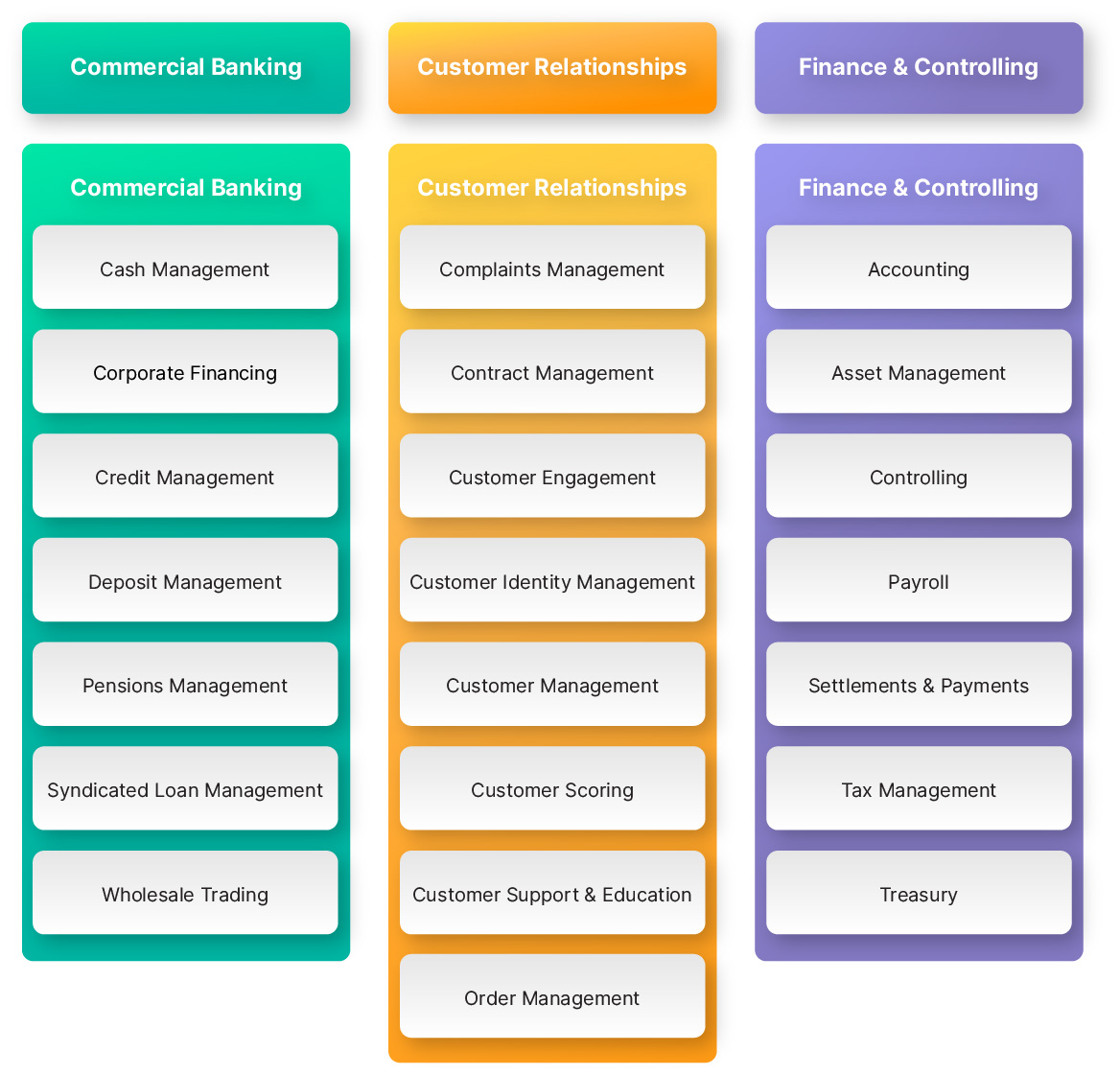
Here we see an example of functionalities inside the business capability that represent the subdomain of the problem domain. Think about it as subsystems inside the system, creating smaller and more specific microservices that can run and be maintained independently.
II.1.3 Service per team
In a Service per team pattern, each of the business capabilities is owned by a single team, and ideally, each team only maintains, builds and operates one service. The size and complexity of the service is scoped to the team’s capacity.
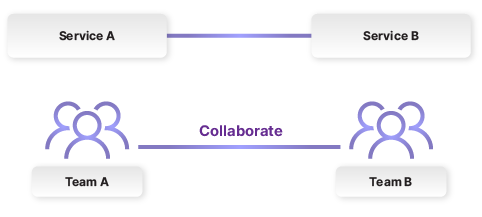
The drawback of this pattern is that implementing features that span services is more complicated and requires teams to collaborate, which can slow build time and add to the volume of work. This pattern is more suitable for more digitally mature organizations, and it is recommended to start with Decompose by Business Structure and Decompose by Sub Domain first, and then assign the build of any microservice to each team by problem domain.
II.2 Data Management Pattern
Most applications require data as an input, and produce data as an output, while the data processing itself might involve persisting the data or retrieving data from another source. In a monolithic architecture, this can be achieved by providing data storage that can be accessed by any components inside the application. However, in microservices this can be challenging because each service no longer resides in the same application. There are several patterns that can be used to allow for data processing and retrieval from a variety of sources:
II.2.1 Database per Service
This pattern aims to make services loosely coupled by providing each service with its own data storage so that they can be developed, deployed, and scaled independently. Each service can then have a different type of data storage optimized for their usage, for example RDBMS, graph, or NoSQL.
There are three common approaches to database storage that are commonly used in microservices.
-
- One database per service. Each service will have its own database isolated from other services to ensure that only the services that are responsible for the data output will manage the data.
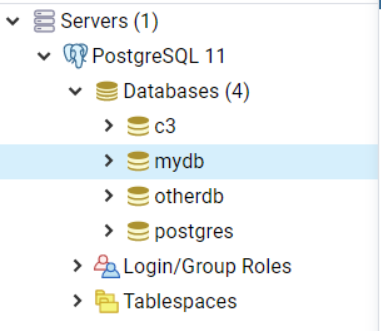
- One schema per service. All services will use the same database; however, each service is assigned a specific schema.
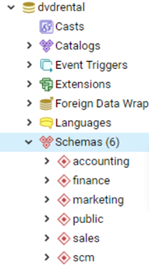
- Private tables per service. All services utilise the same database and schema; however, each service is assigned a specific table.
II.3 Communication Pattern
It’s a common practice in microservices that each service has its own data storage. But it’s also not unusual to see that one service might need to access data from other services. One could share the data storage of one service so that other services can access the data, but this is considered an anti-pattern, creating coupling between the services and removing the value of the microservices.
Communication patterns can then facilitate this scenario, where one service needs to communicate with others to perform its task whether that’s in the form of sending or receiving data. There are several patterns available that can be used for this and avoid coupling between each service and maintain the integrity of your microservice architecture.
II.3.1 Domain Events
A Domain Events pattern aims to resolve the communication problems by providing a specific mechanism to share the data, without sharing the data storage by publishing any activities that happened inside one service. The activities could be data modification, creation, or deletion.

This pattern uses an event-driven approach, where each service publishes domain events for any domain activities that happened, such as when new data is created. Other services subscribe to the domain events and store the data for their own usage individually, which can be achieved through any asynchronous process, like an event bus.
II.3.2 API Composition
In some scenarios, there is a need to retrieve data across multiple services and aggregate the data, such as when generating a report. In this case, an API Composition pattern should be used. This pattern uses a “composer” as a component that will retrieve data from multiple services and aggregate them as necessary.
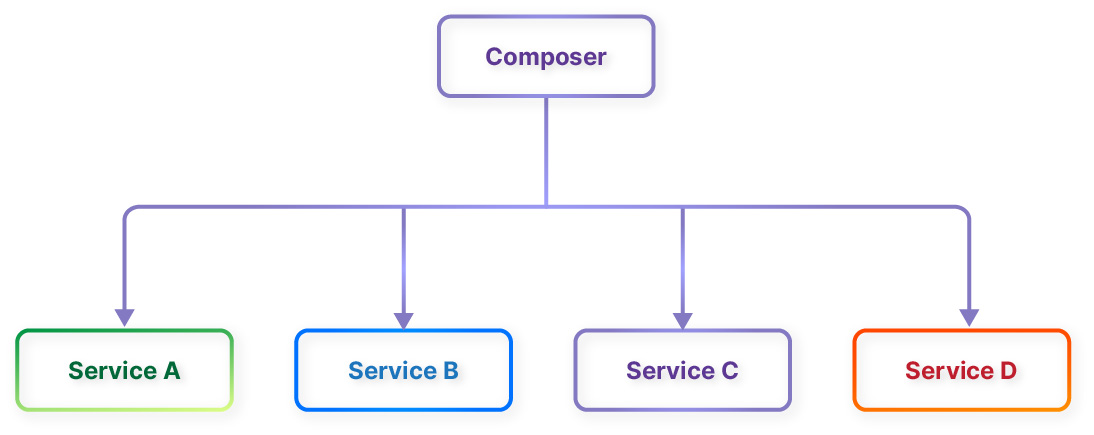
It is recommended to use asynchronous processing to avoid blocking calls, which will reduce the performance. Asynchronous processing calls to other services will be performed without waiting for other calls to finish first. Aggregating the data is performed after all asynchronous calls are finished.
II.4 Transactional Patterns
A transaction is a single unit of work that contains one or more processes, which should result in all processes being completed, or nothing at all. This concept is typically used in the database system to guarantee the consistency of the data. In monolithic applications, this is automatically managed by the database system, however, in microservices each service has its own database. Therefore, each transaction can be automatically managed by the database system if the transaction is performed in a single service. This is referred to as ‘Local Transaction’.
If the transaction spans across multiple services, then a global transaction is needed, which could be achieved through something like Saga as outlined below.
II.4.1 Saga
This pattern was first introduced by Hector Garcia-Molina in his paper “Sagas”. He explains that Saga is a long-lived transaction that can be written as a sequence of transactions that are interleaved with other transactions. In other words, Saga breaks a global transaction into multiple local transactions. There are two styles of Saga implementation – Choreographed and Orchestrated.
Choreographed Saga
In a Choreographed saga, each local transaction publishes events that trigger local transactions in other services. This means that one service can publish an event that will be subscribed to by other services to create another local transaction. If one of the services failed to process the local transaction, they should publish a compensating event that tells the other participating services to undo the transaction.
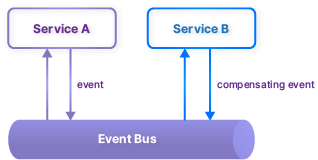
Orchestrated Saga
In an Orchestrated saga, each local transaction is managed by an orchestrator. The orchestrator resides in the service that initiates the transaction. The orchestrator will publish a specific event for a specific service which tells the service to create a local transaction. If the transaction failed, the participating services would publish an event to inform the orchestrator, then the orchestrator will publish a compensating event that tells the other service to undo the transaction.
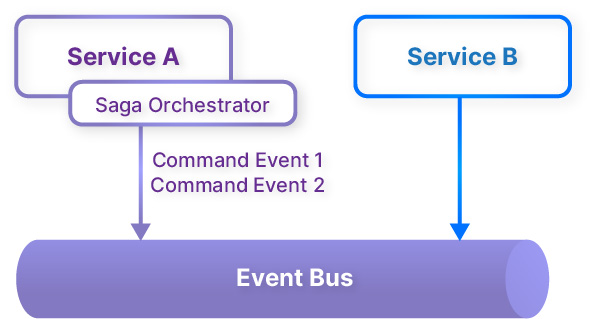
II.5 Deployment Pattern
For a Deployment Pattern, there are several approaches that can be used:
- Multiple services per host, and all services are deployed into one host machine.
- One service per host, and each service is deployed as one host machine.
- One service per VM, and each service is deployed as one virtual machine.
- One service per container, and each service is deployed as one container.
The recommended approach is to use one service per container. As stated in the “Microservices Adoption in 2020” survey from O’Reilly, almost half (49%) of respondents who describe their deployments as “a complete success” also deploy most of their microservices (75-100%) in containers. The majority (83%) of respondents who describe their microservices efforts as “Not successful at all” are using some means other than containers to create their instances.
Containerization technology was originally developed in 2004. However, Docker popularized this technology in 2014 and now it has become best practice when deployingmicroservices. The graphic below outlines a brief history of Containerization technology.

There are several reasons why containerization technology is best practice for microservice architecture:
- Less Overhead, it uses a shared kernel (operating system) with the host machine.
- Portable, it can be easily deployed to multiple different operating systems.
- Isolated, each container is isolated from the others even if it is deployed in the same host machine.
Conclusion
Although microservices offer great advantages, they also introduce high levels of complexity to the architecture and can increase the failure risk.
Microservices patterns aim to tackle this complexity and minimize the risks associated with microservices development and to give guidance on
how to adopt a microservices architecture. None of this should veer organisations from moving towards a microservice architecture, as the value benefits are so great from speed of deployment to ongoing maintenance of code. Instead, developers, scrum masters and those looking to decompose a monolithic application should go into the project eyes wide open and consider the structure of deploying this architecture in your organisation before a single line of code is created. This is key to delivering on the incredible benefits of Microservice architecture.
If you are considering adopting a microservices architecture in your organisation Mitrais highly recommends revisiting the references below and adopting the Microservice patterns described in this paper.
And always remember Lewis’s Zen Koan, “a microservice should be as big as my head!”
References:
Cloud Microservices – Global Market Trajectory & Analytics. Research and Market. https://www.researchandmarkets.com/reports/4804268/cloud-microservices-global-market-trajectory
Denman, James. Business Capability. Tech Target. https://www.techtarget.com/searchapparchitecture/definition/business-capability
Evans, Eric. 2003. Domain-Driven Design: Tackling Complexity in the Heart of Software. Addison-Wesley Professional
Fowler, Martin. Microservices. MartinFowler.com. https://martinfowler.com/articles/microservices.html
Hector et al. 1987. Sagas. Princeton University
Lewis, James. Scale, Microservices and Flow. Codecamp. The One with Architecture. https://codecamp.ro/architecture-conference-february
Mike et al. Microservices Adoption in 2020. O’Reilly. https://www.oreilly.com/radar/microservices-adoption-in-2020/
Richardson, Chris. Microservices Pattern. Microservies.io. https://microservices.io
A Lifetime of Curiosity, with Arif Nazar Purwandaru - Evangelist

Based in Jogjakarta, Arif is one of our Evangelists, dedicated to producing high-quality, end-to-end systems for our clients. With a lifetime passion for computers, software, and IT in general, read on to learn more about how Arif went from 3rd rank in his class and being banned from computers, to one of the premium software engineers at Mitrais.
Arif was a curious child, always asking questions, particularly about how different kinds of technology worked, from landlines to TV pictures, from software to hardware. It was this that led his father to buy him a new computer after he graduated high school, a day he thought as “my happiest day I’ve ever had in my childhood”. He began to learn about computing software and hardware and became quite obsessed with everything he could learn about computing. This unfortunately resulted in a ruined school performance, as there simply was not enough hours in the day to consume everything IT related AND study. Hence, he achieved 3rd rank in his class and his parents banned him from everything to do with computers. His favourite personal quote, that has always given him strength when dealing with a difficult problem is “So verily, with the hardship, there is relief. Verily, with the hardship, there is relief…”, and that seems quite apt in hindsight. Little did his parents know that being banned from computing would light a fire in his belly, and drive him towards computers even further, setting himself the ambitious target to get into one of the top 3 universities in Indonesia to study Computer Science.
Through his time at university, Arif developed a keen interest in IT coding, which has stayed with him to this day, with most of his downtime spent on anything and everything related to coding, from learning new frameworks, to new languages and teaching. He worked for several software houses across Jakarta but found the lifestyle in Indonesia’s biggest city to be far too stressful to be conducive to living a good life. As he was considering a move to a new city, a role at Mitrais opened up for a software engineer, and the rest, as they say, is history.
Arif particularly enjoys the comradery and the variety involved in working at Mitrais. His dedication to producing high-quality software, and having the time to do the work well, has meant that he has been able to greatly improve his skills during his time with Mitrais. For Arif, it’s all about the challenge: “With the challenges and impediments, I’ve been through, they make me even stronger to face the next one”.
He is passionate about learning how different systems work, how best in class software systems are created, and learning about the entirety of the technology stack. That commitment to quality and excellence is why he continues to be one of Mitrais’ highly valued employees.
Thank you so much for sharing your story with us Arif, Mitrais is proud to have you as part of our team and a member of our family.


